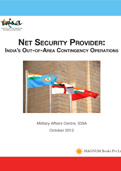 Cooperative Security Framework for South Asia | Institute for Defence Studies and Analyses
Cooperative Security Framework for South Asia | Institute for Defence Studies and AnalysesThis volume brings together views of some of the most eminent scholars and security analysts from South Asia on the challenges and prospects of a cooperative security framework (CSF) in the region. The objective of the volume is to generate debate on CSF and forge a consensus on the issue at the Track-II level. The contributions critically analyse such frameworks in different regions and explore whether it is possible and practicable in the South Asian region. Despite strong historical and cultural linkages the region has been suffering from underdevelopment due to lack of cooperation and cohesive policy. The region is also vulnerable to serious non-traditional security threats in future. There is an urgent need for countries to overcome mutual suspicion and mistrust, and work towards the evolution of a cooperative security framework which is both strong and binding.
 India's Neighbourhood: The Armies of South Asia | Institute for Defence Studies and Analyses
India's Neighbourhood: The Armies of South Asia | Institute for Defence Studies and Analyses
 U.S. Department of Homeland Security Contract Spending and the Supporting Industrial Base, 2004-2011 | Center for Strategic and International Studies
U.S. Department of Homeland Security Contract Spending and the Supporting Industrial Base, 2004-2011 | Center for Strategic and International Studies U.S.-Turkish Relations | Center for Strategic and International Studies
U.S.-Turkish Relations | Center for Strategic and International Studies